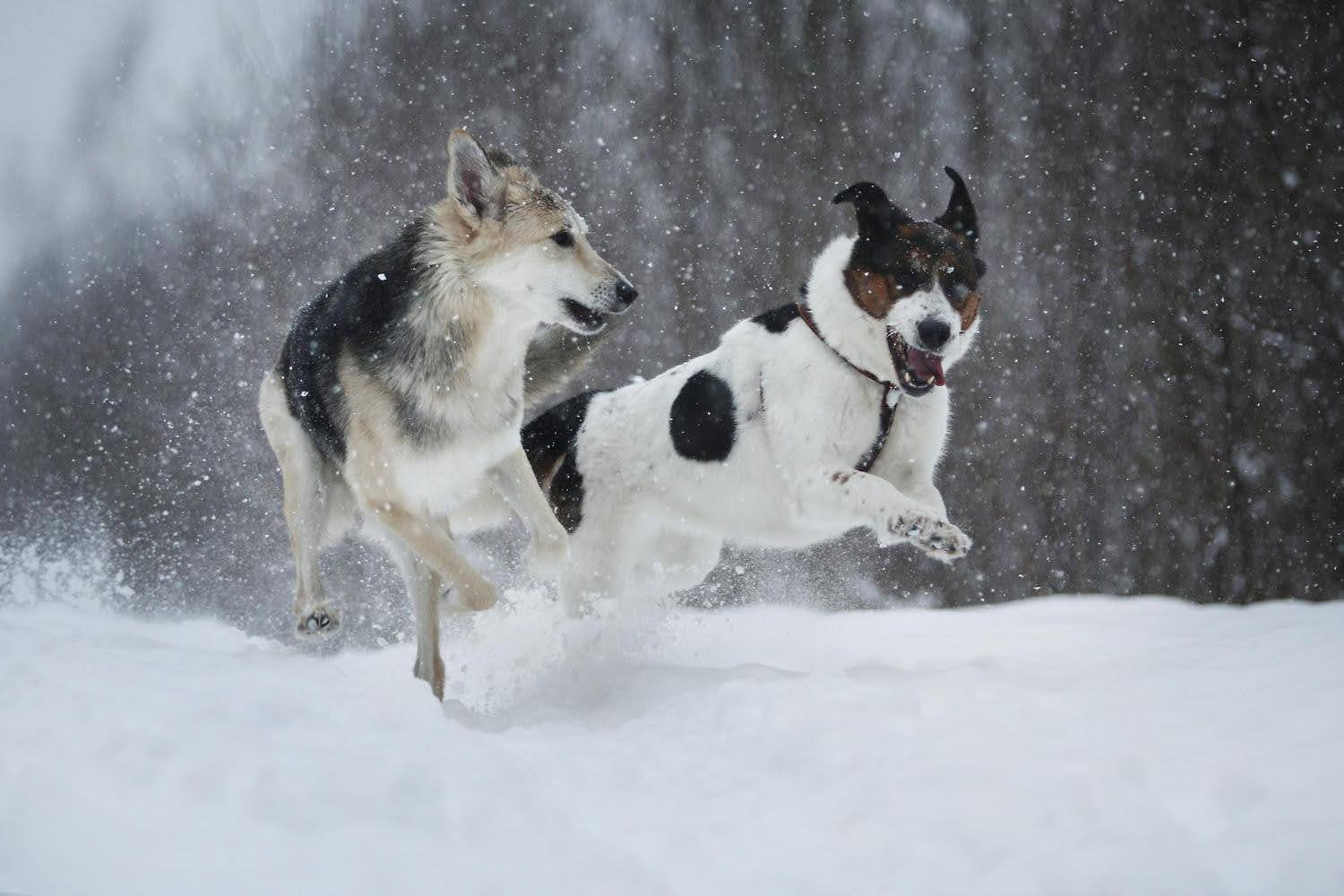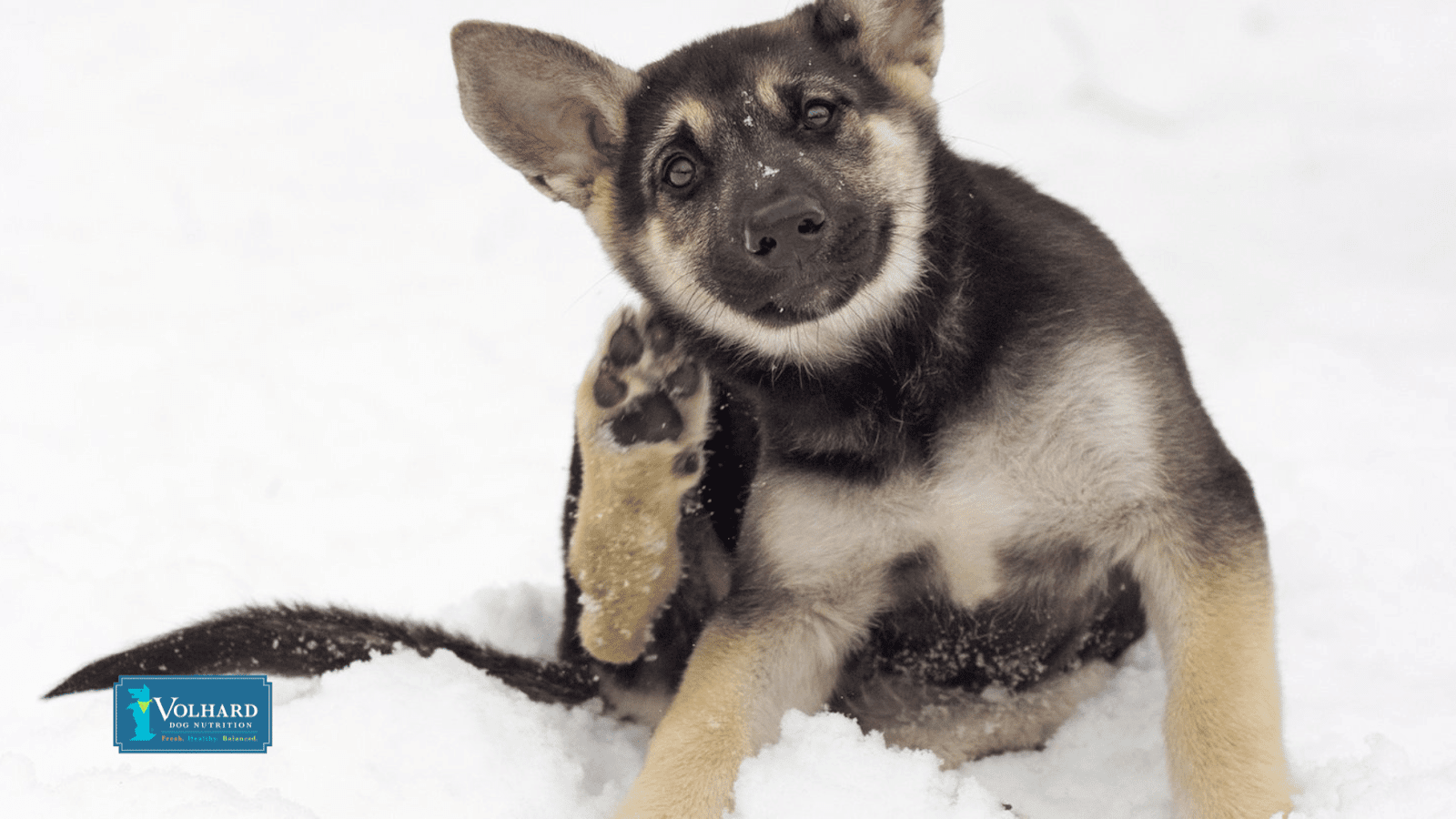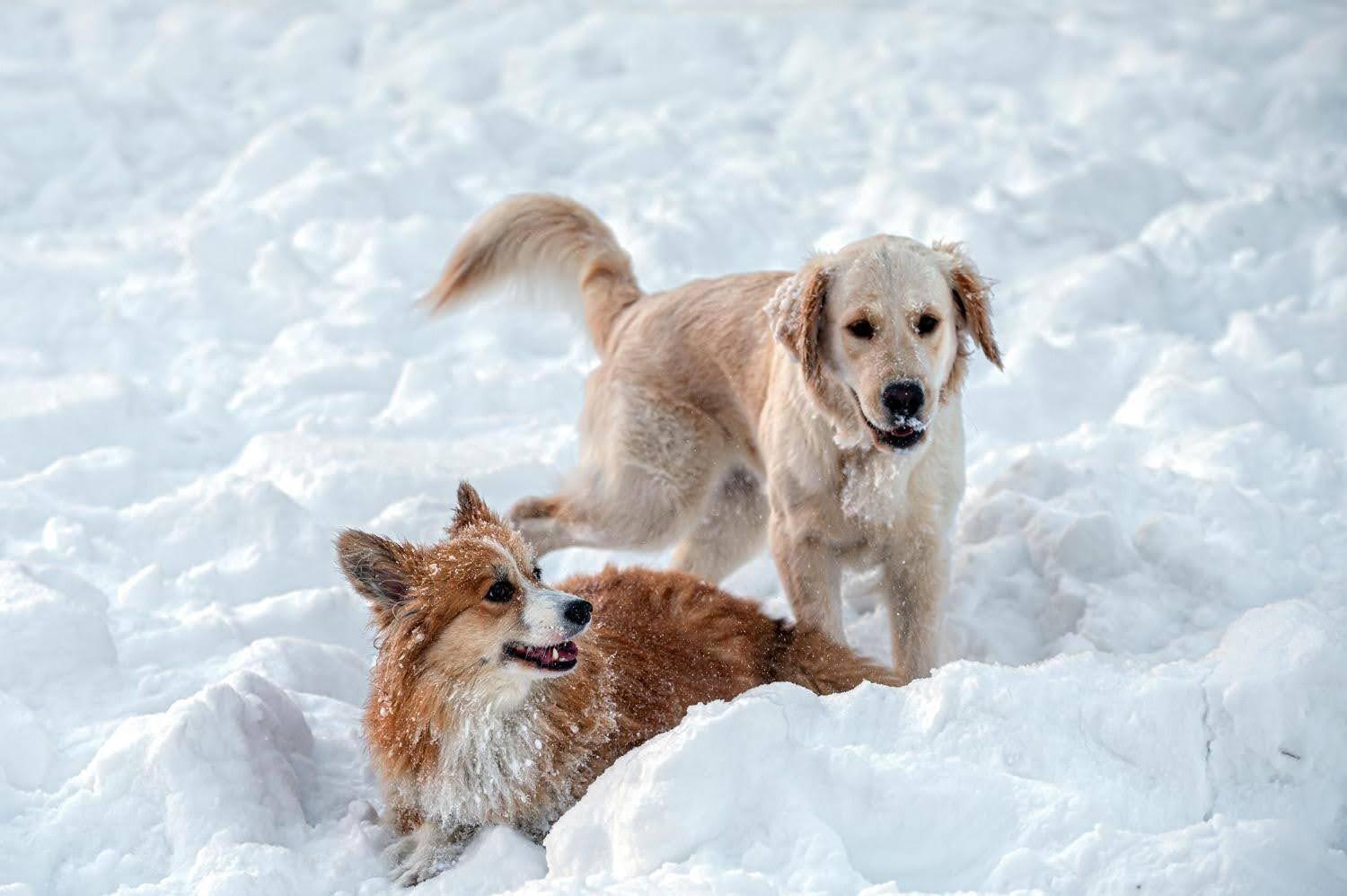Dogs With Dry Skin: How to Prevent and Treat the Winter Itch
Posted by Volhard Dog Nutrition on Dec 10th 2024
Does the winter season have your furry friend scratching relentlessly? That thump, thump, thump keeping you up at night? You're not alone. Winter itch, characterized by dryness, itchiness, and discomfort, affects countless dogs during the cold months, from December through February in colder climates. The good news? With the right approach, you can help your dog's skin stay healthy and itch-free throughout the season.
This guide covers everything you need to know about winter itch, what causes it, how to recognize the signs, and practical solutions to keep your pup comfortable.
Understanding Winter Itch: What's Really Happening
Winter itch is more than just a seasonal annoyance—it's your dog's skin crying out for extra moisture and care. The cold months create a perfect storm of conditions that dry out your dog's skin, both indoors and outdoors.
Why winter hits your dog's skin so hard:
- Outdoor air holds significantly less moisture than warm summer air.
- Wind and freezing temperatures strip away protective oils.
- Indoor heating systems pull even more moisture from the air, creating a desert-like environment.
- Increased indoor time exposes your pup to allergens like dust mites and mold.
- Reduced water intake (yes, dogs drink less in winter!) compounds the problem.
What Can Cause a Winter Allergy in Your Dog?
#1: Dry Air (Indoors and Outdoors)
The seasonal shift brings a dramatic drop in air quality and moisture. Outdoor winter air simply can't hold as much moisture as warm summer air. Add strong winds and frigid temperatures to the mix, and your dog's skin takes a real beating.
The problem intensifies indoors, where heating systems create an even drier environment. Many dog parents unknowingly make this worse by cranking up the heat, a cozy solution for us, but a moisture-sucking nightmare for your dog's skin.
#2: Indoor Allergens
During winter, your dog spends more time inside, which means increased exposure to indoor allergens. Common culprits include:
- Dust mites.
- Mold and mildew.
- Fabric softeners.
- Harsh cleaning chemicals.
- Certain household plants.
Older dogs tend to be especially sensitive to these allergens, so your senior pup may need extra attention during cold months.
Learn more: Check out our article on the most common household dangers for your dog to identify and eliminate potential irritants in your home.
#3: Infections and Parasites
Indoor parasites thrive year-round and can wreak havoc on your dog's skin. Fungi and bacteria feed directly on your dog's skin, causing excessive scratching in specific spots and visible redness.
If you notice your dog obsessively scratching one area or see signs of infection, don't wait; contact your veterinarian. Catching these issues early prevents them from spreading to other pets in your home.
#4: Is Your Dog a Cold-Weather or a Hot-Weather Dog?
Not all dogs are created equal when it comes to winter tolerance. Cold-weather dogs like Samoyeds, Alaskan Malamutes, and American Eskimo dogs have thick, double coats that provide natural protection against harsh conditions. Hot-weather dogs like Chihuahuas, Dachshunds, and Basset Hounds have minimal natural insulation and struggle in cold weather.
If your pup falls into the heat-loving category, extra winter protection, like coats and boots, helps shield their skin from damaging elements.
Important Note on Skin Issues
Before you assume winter itch is the culprit, rule out other conditions. Dry skin can also indicate:
- Fungal or bacterial infections.
- Parasitic infestations.
- Reactions to medications.
- Hypothyroidism.
- Autoimmune diseases.
If your dog is scratching excessively, focusing on one spot, or showing signs beyond dry, flaky skin, schedule a vet visit to rule out these possibilities.
6 Tips on How to Prevent Winter Itch
They say an ounce of prevention is worth a pound of cure, and the same goes for your dog's skin in winter. The best way to treat your dog's dry skin in winter is to prevent them from getting itchy skin in the first place. Even if they already have dry skin, you can follow these steps, and their skin should naturally return to normal:
- Keep your dog hydrated.
- Shield your dog's skin from snow, water, and road salt or ice melt.
- Reduce bathing.
- Brush your dog's coat daily.
- Provide a humid environment within your home.
- Consider fatty acid supplements.
#1: Add Humidity to the Environment
You can't change outdoor weather, but you absolutely can control the air quality indoors. A small humidifier in your dog's favorite room adds moisture back into the air and creates a healthier environment for her skin.
Pro tip: Keep your home at a comfortable temperature rather than cranking up the heat. Every degree above 70°F further dries out the air. Wear an extra sweater instead; your dog's skin will thank you.
If your humidifier isn't working as expected, the temperature might be the culprit. Extra heat is the enemy of moisture, defeating your humidifier's purpose entirely.
#2: Proper Hydration is Everything
Dogs need consistent hydration year-round, but many dog parents overlook winter water intake. In fact, moisture evaporates from your dog's body faster in winter than in summer due to the dry air, meaning it may need even more water during cold months.
Hydration goes beyond the water bowl. The best approach is a hydrated diet that naturally supports skin health. Creating a nutritious meal with Volhard NDF2 is easier than you think—watch our video to see how.
Boost hydration with broths:
- Bone broth provides mineral and amino acid content that supports skin health.
- Meat broth offers a low-histamine option for sensitive dogs.
- Mushroom broth adds nutritional depth and hydration.
Learn more about these nourishing options in our guides to bone broths, meat broths, and mushroom broths.
#3: Consistent Grooming
Winter requires a different grooming approach than other seasons. Consistent, gentle brushing removes dandruff, eliminates bacteria, and reveals healthy fur underneath—but don't overdo it.
Winter grooming guidelines:
- Brush 1-2 times per week.
- Bathe only once per month (or less if possible).
- Bathe at home or at the groomer's less frequently than in other seasons.
- Keep post-walk towel-downs quick and gentle.
Why reduce bathing? Each bath strips away natural oils that protect your dog's skin from harsh winter conditions. If your pup is a mud magnet, gently rub him down with a towel after walks, paying special attention to his paws—they collect deicing salt that can cause allergic reactions.
Related reading: Discover more in our complete guide to reducing excessive shedding with a proper diet.
#4: Winter Protection
Dogs that don't tolerate cold well need extra protection. Winter coats and boots do more than keep them warm; they shield their skin from harsh weather and damaging substances like deicing salt.
Your pup might resist boots initially. Approach training with patience, and pick the warmest times of day for outdoor time (usually midday). This two-pronged approach gives her skin maximum protection while keeping her comfortable.
#5: Moisturize Your Dog's Skin
When environmental changes alone aren't enough, topical moisturizers provide targeted relief. Both natural options and pharmacy products work well when used consistently.
Effective natural moisturizers:
- Coconut oil.
- Pure aloe vera gel.
- Dog-safe paw balms.
Apply these in combination with a humidifier and grooming routine for enhanced results. Don't forget to check your dog's paw pads regularly for cracks and moisturize with an appropriate product to maintain paw health.
#6: Healthy Fats and Oils
Your dog's skin cells need extra nutritional support during winter to maintain their cycles and stay resilient. Omega-3 fatty acids are game-changers for dry, itchy skin, reducing inflammation and revitalizing skin cells.
Best fatty acid sources:
- Marine-based fats like krill oil, algal oil, or small fatty fish provide optimal omega-3 levels.
- Plant-based options like coconut oil, and flaxseed oil supplement an omega-3 and omega-6-rich diet.
Learn more: Explore the amazing benefits of omega-3s and krill oil. Plus, discover why adding fish to your dog's diet makes such a difference for skin health.

A Parting Reminder
Dry, itchy skin is a common sight amongst dogs during the winter season. From lack of moisture to indoor allergens and parasites, your dog's skin needs extra care during the chilly winter months. Fortunately, adding certain foods to his diet, coupled with developing a winter skincare protocol, will help your canine companion overcome the winter season with healthy, itch-free skin.
Volhard Dog Nutrition and its expert nutritionists offer online consultations to help more dog parents discover why, what, and how to feed their dogs the healthiest of foods! Speaking to a Volhard nutritionist will help you understand the inseparable relationship between healthy food, a healthy body, and a healthy mind.

Winter Itch FAQs for Dog Parents
Q: How do I know if my dog has winter itch versus another skin condition?
Winter itch typically shows up as general dryness, mild itching, and flaky skin across your dog's body during cold months. However, if you notice excessive scratching in one specific spot, visible redness, hair loss, scabs, or signs of infection, contact your veterinarian to rule out allergies, parasites, fungal infections, or other conditions. When in doubt, always reach out to your vet, who can provide peace of mind and a proper diagnosis.
Q: Can I start treating winter itch before it starts?
Absolutely! Prevention is far easier than treatment. Start implementing these strategies (adding humidity, increasing hydration, adjusting grooming) in late fall before winter weather arrives. Introducing omega-3 supplements and broths in October or early November gives your dog's skin a head start in building resilience. Think of it as seasonal preparation, just like you would for yourself.
Q: My dog drinks very little water in winter. What's the best way to encourage more hydration?
Many dogs naturally drink less in cold weather, so dietary hydration is your best friend. Switching to a diet that includes bone broth, meat broth, or mushroom broth dramatically increases water intake without forcing your pup to drink from a bowl. You can also try adding low-sodium broth to her regular meals or offering it as a warm snack. Hydration through food feels more natural for dogs than additional water bowls, especially in winter.
Q: Are humidifiers really necessary, or can I manage with other methods?
While humidifiers aren't mandatory, they're incredibly effective at combating the dry indoor air that winter creates. If budget is a concern, focus first on dietary hydration, reducing bathing frequency, and adding topical moisturizers to provide significant relief. However, if your dog continues struggling despite these efforts, a humidifier becomes a worthwhile investment. Think of it as supporting your other efforts rather than a standalone solution.
Q: What's the fastest way to see improvement in my dog's skin?
Patience is key, but you'll likely see improvements within 2-3 weeks by combining multiple strategies. Start with hydration (through diet and broth), reduce bathing, add a humidifier if possible, and introduce omega-3 supplements. Track which changes make the biggest difference for your dog. If you're not seeing improvement after a month, reach out to a veterinarian or schedule a consultation with a Volhard nutritionist to create a personalized plan.
References
- Campbell, Karen L. The Pet Lover's Guide to Cat & Dog Skin Diseases. Saunders Elsevier, 2006.
- Heinrich, Nicole A., et al. Skin Diseases of the Dog and Cat. CRC Press, Taylor & Francis Group, 2019.



